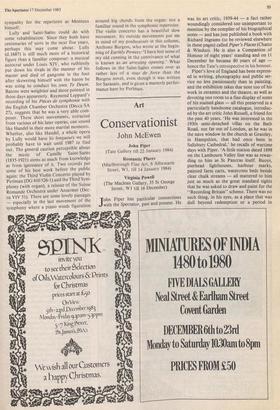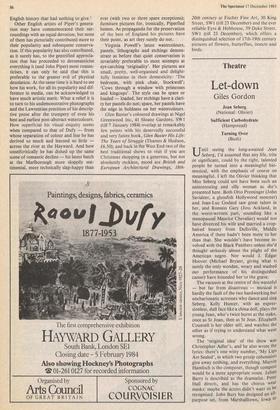Art
Conservationist
John McEwen
John Piper
(Tate Gallery till 22 January 1984) Romantic Places (Marlborough Fine Art, 6 Albemarle
Street, WI, till 14 January 1984)
Virginia Powell
(The Maclean Gallery, 35 St George Street, WI till 16 December) John Piper has particular connections with the Spectator, past and present. He was its art critic, 1939-44 — a fact rather woundingly considered too unimportant to mention by the compiler of his biographical notes — and has just published a book with Richard Ingrams (to be reviewed elsewhere in these pages) called Piper's Places (Chatto & Windus). He is also a Companion of Honour of eight years' standing and on 11 December he became 80 years of age hence the Tate's retrospective in his honour.
Piper's love of England has been express- ed in writing, photography and public ser- vice no less passionately than in painting, and the exhibition takes due note too of his work in ceramics and the theatre, as well as devoting one room to a fine display of some of his stained glass — all this preserved in a particularly handsome catalogue, introduc- ed by the art critic John Russell, a friend for the past 40 years. 'He was interested in the 1930s semi-detached villas on the Bath Road, not far out of London, as he was in the nave window in the church at Grateley, in Hampshire, that had once been in Salisbury Cathedral,' he recalls of wartime days with Piper. 'A little station dated 1898 on the Lambourn Valley line was as rewar- ding to him as St Pancras itself. Buoys, pierhead lighthouses, harbour marks, painted farm carts, watercress beds beside clear chalk streams — all mattered to him just as much as the great standard sights that he was asked to draw and paint for the "Recording Britain" scheme. There was no such thing, in his eyes, as a place that was dull beyond redemption or a period in
English history that had nothing to give.'
Other English artists of Piper's genera- tion may have commemorated their sur- roundings with an equal devotion, but none of them has pictorially contributed more to their popularity and subsequent conserva- tion. If this popularity has also contributed, as it surely has, to the gentrified apprecia- tion that has proceeded to deromanticise everything it (and John Piper) most roman- ticises, it can only be said that this is preferable to the greater evil of physical desolation. At the same time it is hard to see how his work, for all its popularity and dif- ference in media, can be acknowledged to have much artistic merit. What a relief it is to turn to his undemonstrative photographs and the Lawrentian precision of his descrip- tive prose after the trumpery of even his best and earliest post-abstract watercolours. How superficial his visual enquiry seems when compared to that of Dufy — from whose separation of colour and line he has derived so much and learned so little across the river at the Hayward. And how unselfcritically he has dished up the same scene of romantic decline — his latest batch at the Marlborough more sloppily sen- timental, more technically slap-happy than ever (with two or three spare exceptions); furniture pictures for, ironically, Piperfied homes. As propaganda for the preservation of the best of England his pictures have their point, as art they surely do not.
Virginia Powell's latest watercolours, pastels, lithographs and etchings demon- strate as before that quiet conservatism is invariably preferable to most attempts at eye-catching 'originality'. Her pictures are small, pretty, well-organised and delight- fully feminine in their domesticity: 'The bedroom, with pink chair, Stockwell'; 'Cows through a window with primroses and kingcups'. The style can be spare or loaded — loaded, her etchings have a clari- ty her pastels do not; spare, her pastels have the edge in boldness on her watercolours.
Glen Baxter's coloured drawings at Nigel Greenwood Inc, 41 Sloane Gardens, SW I (till 7 January 1984) overlap at remarkably few points with his deservedly successful and very funny book, Glen Baxter His Life: The Years of Struggle (Thames & Hudson, £6.50); and back in the West End two of the best traditional shows to visit if you are Christmas shopping in a generous, but not absolutely reckless, mood are British and European Architectural Drawings, 181h-
20th century at Fischer Fine Art, 30 King Street, SW1 (till 23 December) and the ever reliable Eyre & Hobhouse, 39 Duke Street, SW1 (till 23 December), which offers a distinguished selection of 17th-19th century pictures of flowers, butterflies, insects and birds.







































































 Previous page
Previous page